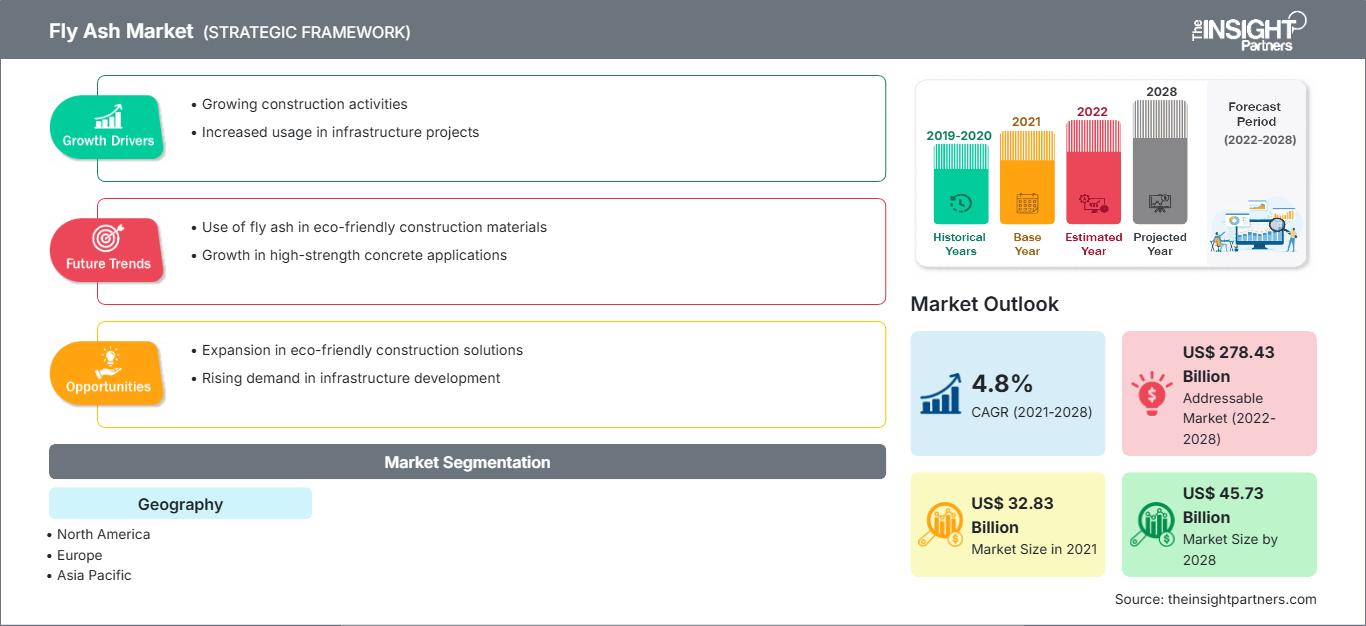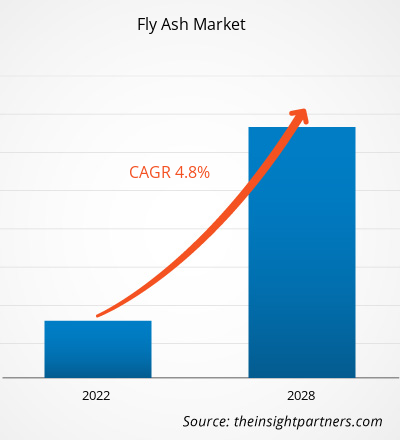[Rapporto di ricerca] Il mercato delle ceneri volanti è stato valutato a 32,83 miliardi di dollari nel 2021 e si prevede che raggiungerà i 45,73 miliardi di dollari entro il 2028; si prevede una crescita a un CAGR del 4,8% dal 2021 al 2028.
ANALISI DI MERCATO
Le ceneri volanti vengono prodotte come residuo della combustione e contengono particelle fini come biossido di silicio, ossido di alluminio, ossido ferrico e talvolta ossido di calcio. Si tratta di una polvere grigia fine con proprietà pozzolaniche e può reagire con la calce per formare composti cementizi. Sono utilizzate in un'ampia gamma di applicazioni, tra cui la miscelazione di cemento e calcestruzzo, miniere e dighe, discariche, calcestruzzo geopolimerico, tra gli altri. Migliora le prestazioni del calcestruzzo durante la miscelazione e funge anche da catalizzatore per la conversione del polietilene durante la pirolisi.
FATTORI DI CRESCITA E SFIDE
La crescita costante del settore edile sta incrementando significativamente la crescita del mercato globale delle ceneri volanti. I paesi dell'Asia-Pacifico, come Stati Uniti, Cina e India, vantano il più grande volume di attività di costruzione al mondo. L'elevato tasso di attività edilizia crea un'enorme domanda di vari materiali da costruzione. Le ceneri volanti vengono utilizzate in molteplici applicazioni specifiche dell'edilizia, come cemento, calcestruzzo, mattoni e blocchi. L'uso delle ceneri volanti per una varietà di applicazioni nel settore edile è in aumento. Inoltre, il crescente utilizzo delle ceneri volanti in diverse applicazioni sta ulteriormente stimolando la crescita del mercato globale delle ceneri volanti. Le ceneri volanti vengono utilizzate in varie applicazioni come cemento e calcestruzzo, blocchi e mattoni, attività minerarie, riempimenti e argini, e molte altre. Grazie alla sua proprietà pozzolanica, l'uso delle ceneri volanti nel calcestruzzo è molto vantaggioso, in quanto ne migliora la durabilità. Nella produzione di calcestruzzo Portland, la cenere volante viene utilizzata come materiale cementizio supplementare (SCM) per migliorarne le prestazioni. I mattoni in cenere volante vengono utilizzati come materiale da costruzione al posto dei mattoni in argilla. Rispetto ai mattoni in argilla tradizionali, i mattoni in cenere volante sono più leggeri e robusti, economici, non richiedono intonaco e possono contribuire a ridurre i costi di costruzione e l'erosione del suolo. Tuttavia, la scarsa consapevolezza dei benefici o dei potenziali utilizzi della cenere volante potrebbe limitarne la crescita sul mercato. La cenere volante è una materia prima importante per diverse applicazioni. Tuttavia, la comprensione della chimica della cenere volante e dei suoi derivati per un utilizzo appropriato nelle applicazioni finali è carente. La scarsa consapevolezza pubblica sui prodotti è una delle cause del basso utilizzo della cenere volante.
Personalizza questo rapporto in base alle tue esigenze
Potrai personalizzare gratuitamente qualsiasi rapporto, comprese parti di questo rapporto, o analisi a livello di paese, pacchetto dati Excel, oltre a usufruire di grandi offerte e sconti per start-up e università
Mercato delle ceneri volanti: Approfondimenti strategici

- Ottieni le principali tendenze chiave del mercato di questo rapporto.Questo campione GRATUITO includerà l'analisi dei dati, che vanno dalle tendenze di mercato alle stime e alle previsioni.
Potrai personalizzare gratuitamente qualsiasi rapporto, comprese parti di questo rapporto, o analisi a livello di paese, pacchetto dati Excel, oltre a usufruire di grandi offerte e sconti per start-up e università
Mercato delle ceneri volanti: Approfondimenti strategici

- Ottieni le principali tendenze chiave del mercato di questo rapporto.Questo campione GRATUITO includerà l'analisi dei dati, che vanno dalle tendenze di mercato alle stime e alle previsioni.
SEGMENTAZIONE E AMBITO DEL RAPPORTO
L'"Analisi del mercato globale delle ceneri volanti fino al 2030" è uno studio specializzato e approfondito con particolare attenzione alle tendenze e alle opportunità di crescita del mercato globale delle ceneri volanti. Il rapporto mira a fornire una panoramica del mercato globale delle ceneri volanti con una segmentazione dettagliata per tipologia, applicazione e area geografica. Il mercato globale delle ceneri volanti ha registrato una forte crescita nel recente passato e si prevede che questa tendenza continuerà durante il periodo di previsione. Il rapporto fornisce statistiche chiave sul consumo di ceneri volanti a livello mondiale, insieme alla loro domanda nelle principali regioni e paesi. Inoltre, il rapporto fornisce una valutazione qualitativa di vari fattori che influenzano l'andamento del mercato delle ceneri volanti nelle principali regioni e paesi. Il rapporto include anche un'analisi completa dei principali attori del mercato delle ceneri volanti e dei loro principali sviluppi strategici. Sono inoltre incluse diverse analisi sulle dinamiche di mercato per aiutare a identificare i principali fattori trainanti, le tendenze di mercato e le opportunità redditizie del mercato delle ceneri volanti, che a loro volta aiuterebbero a identificare le principali fonti di reddito.
Inoltre, l'analisi dell'ecosistema e l'analisi delle cinque forze di Porter forniscono una visione a 360 gradi del mercato globale delle ceneri volanti, che aiuta a comprendere l'intera catena di approvvigionamento e i vari fattori che influenzano la crescita del mercato.
ANALISI SEGMENTALE
Il mercato globale delle ceneri volanti è segmentato in base alla tipologia e all'applicazione. In base alla tipologia, il mercato delle ceneri volanti è segmentato in tipo C e tipo F. In base all'applicazione, il mercato è classificato come cemento e calcestruzzo, blocchi e mattoni, attività estrattiva, stabilizzazione stradale, riempimenti e rilevati, stabilizzazione dei rifiuti e altri. In base alla tipologia, il segmento di tipo C ha rappresentato un'importante quota di mercato delle ceneri volanti, il che può essere attribuito al crescente utilizzo di ceneri volanti in varie applicazioni. Le ceneri volanti di tipo C si ottengono spesso da carbone subbituminoso e lignite. Le proprietà autoindurenti distintive delle ceneri volanti di tipo C sono dovute alla loro elevata concentrazione di calce viva (CaO). Le ceneri volanti di tipo C sono ideali per miscele ad alte prestazioni, applicazioni precompresse e altre applicazioni che richiedono una maggiore resistenza iniziale. Le ceneri volanti di tipo C sono molto efficaci nella stabilizzazione del terreno, grazie al loro elevato contenuto di calce. In base all'applicazione, il segmento del cemento e del calcestruzzo ha rappresentato un'importante quota di mercato delle ceneri volanti, il che può essere attribuito alla crescente adozione di ceneri volanti nel settore delle costruzioni. Le ceneri volanti vengono utilizzate come materiale cementizio supplementare (SCM) per la produzione di calcestruzzo di cemento Portland. Rispetto al calcestruzzo di cemento Portland con la stessa lavorabilità, l'utilizzo di ceneri volanti di eccellente qualità con elevata finezza e basso contenuto di carbonio riduce il fabbisogno d'acqua del calcestruzzo. Di conseguenza, le ceneri volanti dovrebbero consentire di produrre calcestruzzo con un contenuto d'acqua inferiore. Ciò attirerà ulteriori nuove opportunità di crescita per l'intero settore.
ANALISI REGIONALE
Il rapporto fornisce una panoramica dettagliata del mercato globale delle ceneri volanti in cinque regioni principali, ovvero Nord America, Europa, Asia-Pacifico (APAC), Medio Oriente e Africa (MEA) e America meridionale e centrale. Il Medio Oriente e l'Africa hanno rappresentato una quota significativa del mercato, con un valore di oltre 600 milioni di dollari nel 2022 e una stima di circa 1.000 milioni di dollari nel 2030. Il rapido aumento delle attività di costruzione, soprattutto in Medio Oriente, ha contribuito positivamente alla crescita del mercato in Medio Oriente e Africa. Si prevede inoltre che l'Asia-Pacifico registrerà una crescita considerevole, stimata in oltre 25.000 milioni di dollari nel 2022, attribuibile al crescente utilizzo delle ceneri volanti in varie applicazioni nella regione, che sta trainando la crescita del mercato globale delle ceneri volanti. Si prevede inoltre che il Nord America registrerà una crescita considerevole, stimata in oltre 4.000 milioni di dollari nel 2022, attribuibile al maggiore utilizzo di ceneri volanti nel settore edile, che dovrebbe stimolare la crescita del mercato globale delle ceneri volanti.
SVILUPPI DEL SETTORE E OPPORTUNITÀ FUTURE
Partnership, acquisizioni e lanci di nuovi prodotti sono state le principali strategie adottate dagli operatori che operano nel mercato globale delle ceneri volanti.
- A novembre 2021, LafargeHolcim negli Stati Uniti, Geocycle e CenterPoint Energy ricicleranno le ceneri di carbone delle centrali elettriche dalle discariche per utilizzarle nella produzione di cemento.
- A settembre 2021, Charah Solutions si è aggiudicata un contratto quinquennale di vendita e marketing di ceneri volanti per l'uso vantaggioso delle ceneri volanti di produzione presso la centrale elettrica di Gavin in Ohio.
IMPATTO DEL COVID/IMPATTO DELLO SCENARIO GEOPOLITICO/IMPATTO DI RECESSIONE
La pandemia di COVID-19 ha portato a un calo dei progressi in molti settori in tutto il mondo. La chiusura degli impianti di produzione e le restrizioni commerciali in tutto il mondo hanno portato a vincoli nella catena di approvvigionamento per i produttori di tutto il mondo. La pandemia in corso ha drasticamente alterato lo stato del settore chimico e dei materiali e ha avuto un impatto negativo sulla crescita del mercato delle ceneri volanti. L'attuazione di misure per contrastare la diffusione del virus ha aggravato la situazione e ha avuto un impatto sulla crescita di diversi settori industriali. Molte centrali termoelettriche non erano operative o operavano a capacità ridotta. Ciò ha avuto un impatto negativo sulla produzione e l'utilizzo delle ceneri volanti. La pandemia ha creato una crisi sanitaria globale che ha sconvolto tutti i settori, compreso quello delle costruzioni. La riduzione dell'attività economica ha comportato una minore domanda di nuove strutture commerciali o industriali. La perdita di reddito e la mancanza di fiducia dei consumatori hanno influito negativamente sulla domanda di edilizia residenziale. Inoltre, i cantieri edili hanno dovuto affrontare interruzioni nella catena di approvvigionamento e restrizioni operative. Tuttavia, poiché le economie stanno pianificando di riprendere le loro attività, si prevede che la domanda di ceneri volanti aumenterà a livello globale. Pertanto, il mercato delle ceneri volanti si è ripreso abbastanza bene dalle conseguenze della pandemia e si prevede che crescerà nei prossimi anni.
Approfondimenti regionali sul mercato delle ceneri volanti
Le tendenze regionali e i fattori che influenzano il mercato delle ceneri volanti durante il periodo di previsione sono stati ampiamente spiegati dagli analisti di The Insight Partners. Questa sezione illustra anche i segmenti e la geografia del mercato delle ceneri volanti in Nord America, Europa, Asia-Pacifico, Medio Oriente e Africa, America meridionale e centrale.
Ambito del rapporto sul mercato delle ceneri volanti
| Attributo del rapporto | Dettagli |
|---|---|
| Dimensioni del mercato in 2021 | US$ 32.83 Billion |
| Dimensioni del mercato per 2028 | US$ 45.73 Billion |
| CAGR globale (2021 - 2028) | 4.8% |
| Dati storici | 2019-2020 |
| Periodo di previsione | 2022-2028 |
| Segmenti coperti |
By Geografia
|
| Regioni e paesi coperti | Nord America
|
| Leader di mercato e profili aziendali chiave |
|
Densità degli operatori del mercato delle ceneri volanti: comprendere il suo impatto sulle dinamiche aziendali
Il mercato delle ceneri volanti è in rapida crescita, trainato dalla crescente domanda degli utenti finali dovuta a fattori quali l'evoluzione delle preferenze dei consumatori, i progressi tecnologici e una maggiore consapevolezza dei benefici del prodotto. Con l'aumento della domanda, le aziende stanno ampliando la propria offerta, innovando per soddisfare le esigenze dei consumatori e sfruttando le tendenze emergenti, alimentando ulteriormente la crescita del mercato.

- Ottieni il Mercato delle ceneri volanti Panoramica dei principali attori chiave
PAESAGGIO COMPETITIVO E AZIENDE CHIAVE
Alcuni dei principali attori che operano nel mercato delle ceneri volanti includono, tra gli altri, Boral LTD., Cemex SAB DE CV, Lafargeholcim Ltd., Waste Management, Inc., Charah, LLC, Separation Technologies LLC, Cement Australia PTY Limited, Salt River Materials Group, Ashtech India Pvt. Ltd. e Duromar, Inc.
- Analisi storica (2 anni), anno base, previsione (7 anni) con CAGR
- Analisi PEST e SWOT
- Valore/volume delle dimensioni del mercato - Globale, Regionale, Nazionale
- Industria e panorama competitivo
- Set di dati Excel
Report recenti
Testimonianze
Motivo dell'acquisto
- Processo decisionale informato
- Comprensione delle dinamiche di mercato
- Analisi competitiva
- Analisi dei clienti
- Previsioni di mercato
- Mitigazione del rischio
- Pianificazione strategica
- Giustificazione degli investimenti
- Identificazione dei mercati emergenti
- Miglioramento delle strategie di marketing
- Aumento dell'efficienza operativa
- Allineamento alle tendenze normative






















 Ottieni un campione gratuito per - Mercato delle ceneri volanti
Ottieni un campione gratuito per - Mercato delle ceneri volanti